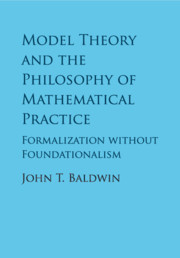Book contents
- Frontmatter
- Dedication
- Contents
- List of Figures
- Acknowledgments
- Introduction
- PART I REFINING THE NOTION OF CATEGORICITY
- PART II THE PARADIGM SHIFT
- PART III GEOMETRY
- 9 Axiomatization of Geometry
- 10 π, Area, and Circumference of Circles
- 11 Complete: TheWord for All Seasons
- PART IV METHODOLOGY
- References
- Index
10 - π, Area, and Circumference of Circles
from PART III - GEOMETRY
Published online by Cambridge University Press: 19 January 2018
- Frontmatter
- Dedication
- Contents
- List of Figures
- Acknowledgments
- Introduction
- PART I REFINING THE NOTION OF CATEGORICITY
- PART II THE PARADIGM SHIFT
- PART III GEOMETRY
- 9 Axiomatization of Geometry
- 10 π, Area, and Circumference of Circles
- 11 Complete: TheWord for All Seasons
- PART IV METHODOLOGY
- References
- Index
Summary
The geometry over a Euclidean field (every positive number has a square root)may have no straight line segment of length π. For example, the model containing only the constructible real numbers does not contain π. We want to find a theory which proves the circumference and area formulas for circles. Our approach is to extend the theory EG so as to guarantee that there is a point in everymodel which behaves as π does. In this chapter we will show that in this extended theory there is a mapping assigning a straight line segment to the circumference of each circle.We first introduce π to the Euclidean scheme by forming a theory EGπ. In a second direction (Chapter 10.2), we note Tarski's axiomatization of ‘Cartesian’ plane geometry, E2. Then we combine the two in a theory E2π to give the theory of real closed fields that include π. Given that the entire project is modern, we give the arguments entirely in the style of modern model theory.
For Archimedes and Euclid, sequences constructed in the study of magnitudes in the Elements are of geometric objects, not of numbers. In a modern account, as we saw already while discussing areas of polygons in Chapter 9.5, we must identify the proportionality constant and verify that it represents a point in any model of the theory.1 Thus this goal diverges from a ‘Greek’ data set and indeed is orthogonal to the axiomatization of Cartesian geometry in Theorem 10.2.1.
This shift in interpretation drives the rest of this chapter. We search for the solution of a specific problem: is π in the underlying field?
π in Euclidean and Archimedean Geometry
We now describe the rationale for placing various facts in the Archimedean data set2 in Notation 9.3.2. Three propositions encapsulate the issue: Euclid VI.1 (area of rectangle), Euclid XII.2 (area of a circle is proportional to the square of the diameter), and Archimedes’ proof that the circumference of a circle is proportional to the diameter. Hilbert showed (Theorem 9.3.4) that VI.1 is provable already in HP5. While Euclid implicitly relies on the Archimedean axiom, Archimedes makes it explicit in a recognizably modern form. Euclid does not discuss the circumference of a circle.
- Type
- Chapter
- Information
- Model Theory and the Philosophy of Mathematical PracticeFormalization without Foundationalism, pp. 234 - 249Publisher: Cambridge University PressPrint publication year: 2018



